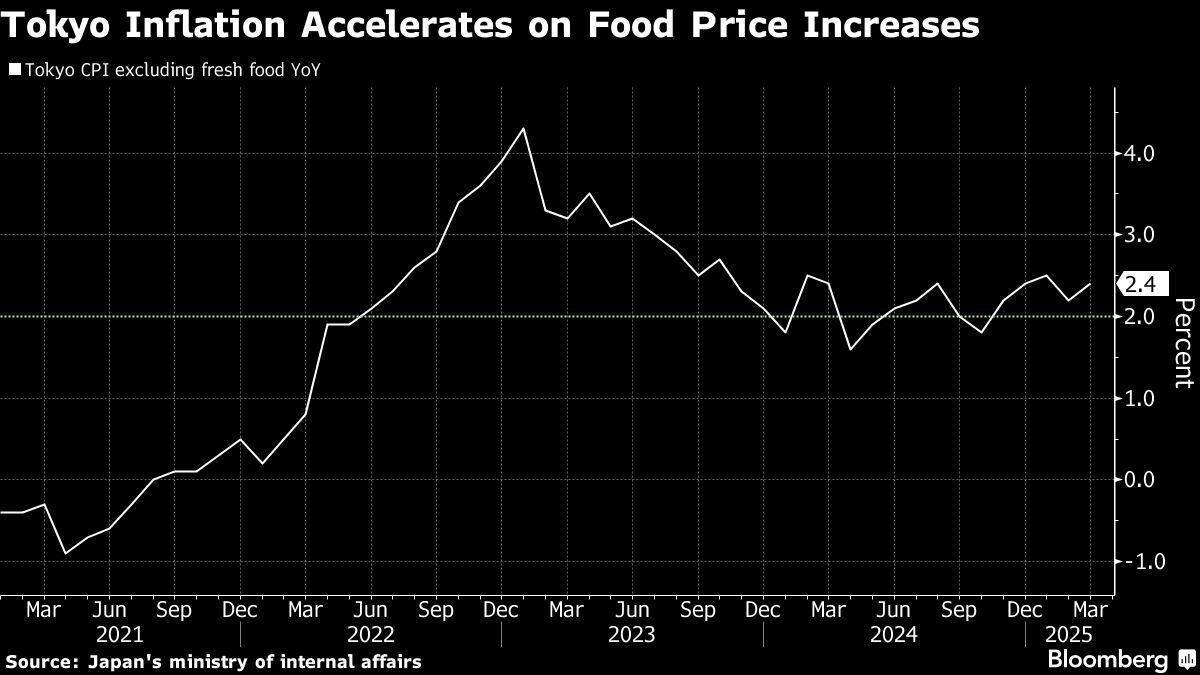
(March 28): The cost of living in Tokyo rose more than anticipated from the previous month, keeping the Bank of Japan (BOJ) on track for further interest rate hikes.
Consumer prices excluding fresh food rose 2.4% in March from a year earlier as inflation in processed food accelerated, according to the Ministry of Internal Affairs on Friday. The result was more than the median economist forecast of 2.2%, and higher than any estimate by economists surveyed by Bloomberg. Overall inflation also picked up to 2.9% from February’s 2.8%.
The yen temporarily gained against the dollar following the report, strengthening to as much as 150.77 against the greenback.
The leading indicator for nationwide inflation is likely to keep BOJ governor Kazuo Ueda mulling over the right timing for further rate hikes. While US President Donald Trump’s tariffs have darkened the outlook for the global economy, Japan’s recent domestic data have illustrated progress towards the BOJ’s stable inflation target, helping speculation over the next rate increase.
While most economists expect the central bank to wait until June or July to raise interest rates again in their base case scenarios, many have said there’s a risk of an earlier move at the May 1 conclusion of the next board meeting.
“Inflation for food excluding fresh food is strong, as well as price gains for household durable goods and services.,” said Nobuyasu Atago, the chief economist of Rakuten Securities Economic Research Institute and a former BOJ official. “The BOJ should expedite the timing of interest rate hikes, and I think there is still a possibility of another rate hike in May.”
Friday’s data showed continued upward pressure from food inflation as non-fresh foods rose 5.6%, including rice prices jumping around 90%. The spike in the cost of rice has caused widespread public concern, forcing the government to release emergency stockpiles of the country’s staple food this month for the first time.
Service prices also rose 0.8% from a year earlier, up from 0.6% in the previous month and the fastest pace since December. The gauge is closely watched by the BOJ to help get an assessment of underlying inflation.
Businesses have continued to pass their costs onto consumers as weakness in the yen lingers and the cost of materials and labour continue to increase. Major food companies have raised the price of 2,343 products in March, around three times the number a year ago, according to Teikoku Databank. Further price increases are planned for April, when the new fiscal year begins.
With interest rates at 0.5%, the lowest among Group of Seven nations, Ueda has defended his gradual approach towards normalisation by noting Japan’s underlying price trend is still “a little” below the BOJ’s target of 2%. Yet Japan’s key nationwide inflation gauge has risen at or above the target for almost three years.
Households have seen their real wages falling or having meager increases in the past few years. Discontent over that reality has fed into a decline in Prime Minister Shigeru Ishiba’s approval rate, as he faces the prospect of a summer general election.
Overnight-indexed swaps on Thursday showed about a quarter of a chance that the BOJ will raise borrowing costs at its next meeting ending on May 1. Some economists doubt it will happen, especially after Trump’s Wednesday announcement that fresh 25% tariffs will be applied on car imports from April 2.
Uploaded by Tham Yek Lee
- Xi's showdown with Li Ka-shing threatens China’s pro-business push
- Tan Kean Soon steps down as T7 Global executive deputy chairman, board says no operational impact
- Company auditor loses RM1.29m to investment scam
- Huawei posts surprise loss after aggressive tech research
- Perak emerges as Malaysia's No 1 sweet corn producer

